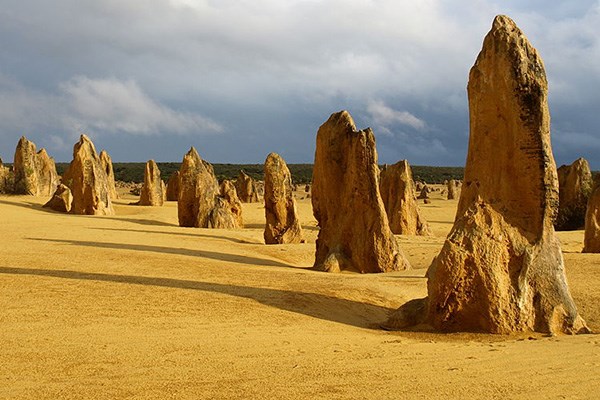Head north out of Perth along the Brand Highway, and about halfway towards Geraldton you’ll find the turn-off to the town of Cervantes and Nambung National Park.
This coastal park, one of several parks and reserves in the area, is named after the river that the local Aboriginal people called Nambung, meaning 'winding'. It has beautiful beaches and dunes, tuart groves and extensive heathlands that burst into flower from August to October (the banksias in particular are out of this world). It is best known, however, for the Pinnacles: hundreds of eerie limestone pillars that rise from the shifting yellow sands.
ABOUT THE PINNACLES



These geological marvels began as crushed seashells that ground down and solidified to limestone under sand dunes along an ancient shoreline. As plant life began to develop on the dunes, water leaching through the acidic layer of humus formed a hard layer of calcrete over the soft limestone. Plant roots eventually expanded through cracks in the calcrete and caused vertical erosion in the limestone, and when the dunes were denuded in a drying climate and got blown along by the wind, they left behind the pillars we see today.
It is thought that this process began about 80,000 years ago, but even today the winds keep uncovering new pinnacles and burying existing ones under sand.
VISITING THE PINNACLES
The 190ha Pinnacles Desert became a popular tourist destination in the late 1960s, when it was added to the existing Nambung National Park. Today the park attracts some 250,000 visitors a year. A sealed road from the town of Cervantes 17km to the north leads into this area, where a 4km unsealed (but perfectly fine) road does a loop through the formations.
Drive the loop by all means, but the location is best appreciated on foot from the car park. There are longer walks too, such as out to the coloured deserts (visit Pinnacles Desert Discovery Centre for more information). Allow yourself two hours in order to circumvent the 4 km trail and access The Pinnacles Lookout.
The entry fee is $12 per passenger vehicle (pensioner discounts apply), payable at the gate. No caravans or trailers are allowed in the park, and these should be left in town or at the parking area next to the access road.
If you’re taking photos, time your visit for the early morning or late afternoon, when the light is at its best and the unique shadows cast by the pillars on the sand add to the drama. Early morning is the best time to spot wildlife, including western greys and emus.
THINGS TO DO NEAR THE PINNACLES
Cervantes itself is a popular windsurfing centre and hosts the annual Slalom Windsurfing Carnival in early December. The fishing is good, as is swimming in the crystal-clear waters protected by inshore reefs. You can also go sandboarding at Sandy Point, 12km north of Jurien Bay (which in turn is 27km north of Cervantes), where there’s a camping area run by the shire for self-sufficient caravanners (modest fee payable to the caretaker).
By all means visit Lake Thetis 1km east of the centre of Cervantes, which has some of the best examples of stromatolites in the world. Stromatolites are layered structures (a bit like coral) formed by microbes relying on photosynthesis, and are the oldest known form of life on earth – fossil remains have been dated back some 3.5 billion years, not long after life itself began.
This is one of the few known locations where stromatolites still exist. They prefer extreme environments that lack predators, such as super-hot springs or, as in Lake Thetis, hypersaline water. The ones living in this lake are thought to be about 2000 years old.
If you’re an experienced four-wheel-driver, head south along a sandy 4WD track that follows much of the coast down to the crayfishing port and windsurfing centre of Lancelin, but you’ll need up-to-date advice and good maps.
The Pinnacles is most easily accessed from the town of Cervantes with accommodation options available for those wanting to visit dramatic limestone pillars. Alternatively, stay in the town of Lancelin and head north to The Pinnacles by 4WD.





